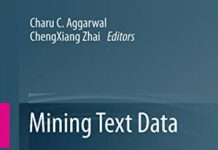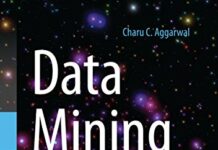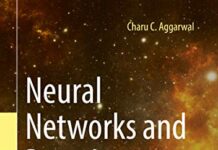
Ebook Info
- Published: 2018
- Number of pages: 938 pages
- Format: PDF
- File Size: 3.66 MB
- Authors: Charu C. Aggarwal
Description
Text analytics is a field that lies on the interface of information retrieval,machine learning, and natural language processing, and this textbook carefully covers a coherently organized framework drawn from these intersecting topics. The chapters of this textbook is organized into three categories:- Basic algorithms: Chapters 1 through 7 discuss the classical algorithms for machine learning from text such as preprocessing, similarity computation, topic modeling, matrix factorization, clustering, classification, regression, and ensemble analysis.- Domain-sensitive mining: Chapters 8 and 9 discuss the learning methods from text when combined with different domains such as multimedia and the Web. The problem of information retrieval and Web search is also discussed in the context of its relationship with ranking and machine learning methods. – Sequence-centric mining: Chapters 10 through 14 discuss various sequence-centric and natural language applications, such as feature engineering, neural language models, deep learning, text summarization, information extraction, opinion mining, text segmentation, and event detection. This textbook covers machine learning topics for text in detail. Since the coverage is extensive,multiple courses can be offered from the same book, depending on course level. Even though the presentation is text-centric, Chapters 3 to 7 cover machine learning algorithms that are often used indomains beyond text data. Therefore, the book can be used to offer courses not just in text analytics but also from the broader perspective of machine learning (with text as a backdrop). This textbook targets graduate students in computer science, as well as researchers, professors, and industrial practitioners working in these related fields. This textbook is accompanied with a solution manual for classroom teaching.
User’s Reviews
Reviews from Amazon users which were colected at the time this book was published on the website:
⭐This is an excellent textbook for academia and industry alike, although the style leans towards academia. The book introduces various machine learning methods in detail like matrix factorization, PLSA, LDA, SVD, clustering, classification, and deep learning. The exposition is clear, intuitive, and certainly not dry, which can sometimes be a risk for mathematically oriented books. Coverage of deep learning includes some unique perspectives on word2vec, RNNs, and LSTMs. Beautiful presentation of word2vec is provided together with its relationship to matrix factorization. Even though word2vec is also covered in Jurafsky (Chapter 16) and in some other books, the details here are far greater than any other book I have seen.The insights and connections in the book are pretty amazing. Word2vec is connected to matrix factorization, SVMs/RFs are connected to nearest neighbors, NMF is connected to PLSA, and so on. Insights are provide on why kernels truly work and the procedure for systematic kernelization of arbitrary problems is provided. Other covered topics include opinion mining, summarization, text segmentation, and information extraction. Examples and pseudocodes are given in many chapters.The book covers all the three aspects of machine learning (deep focus), information retrieval, (light focus), and sequence-centric topics like information extraction/summarization. The style and quality of writing is somewhat similar to “An Introduction to Information Retrieval” by Manning although the content and coverage are quite different (and more extensive). Manning focuses on IR and touches on machine learning, whereas this book focuses on machine learning and touches on IR. The book contains about 500 pages, although the amount of content is larger than other books of comparable size because of the smaller font used.This book is clearly not a programming or implementation book, and it seems to be targeted to university classrooms, with a presentation thatis independent of specific programming frameworks (like Python). This is on par for a university textbook, and preferable for someone from academia. Nevertheless, industry can benefit too, because the pseudocodes and detailed explanations are sufficient for a mathematically and algorithmically competent engineer to implement what they want. The author also provides bibliographic summaries with pointers to softwareresources.
⭐I love this book! It occupies a privileged place in my library. I am a professional computer programmer and Deep Learning programmer. Deep Learning can be used on images and Text. I find that my clients have Deep Learning needs that are related to text documents, text processing. So for me, using Deep Learning on text documents is first priority. This book is university level on the topic. It has enough material for 4 university classes. So I keep it as a reference that I can go back to all the time. I recommend this book for professionals like me who want take advantage of the booming market.
⭐Great book with extensive coverage coupled with lots of intuitionand insight. As one reviewer mentions, it is certainly not a programmingbook and is written as a university textbook. The writing is clearand precise, but it is certainly not a programming recipe or cookbook either.I couple this book with other similar books like Manning’s books andJurafsky’s book to get a full picture of the field. I must say thatthe coverage is heads and shoulders above other books in depth and breadth.How many books discuss IR, general machine learning, deep learning,search engines, and information extraction all at one place?
⭐It’s an excellent book with the right balance between math and intuitive explanations. Any one interested in the nexus between NLP and Machine Learning should read this book. My only negative comment is that all topics are not covered uniformly e.g. there is disproportionately higher coverage of text classification, compared to other topics.
⭐Very well written and easy to read. Covers the principles and builds on those.
⭐very vague
⭐Provides a detailed treatment of the text machine learning.Will appeal to professors, students and researchers.The book is officially classified as a textbook, and is intendedfor classroom teaching in universities.The nice writing style also makes it accessible to practitioners.A lot of explanations are given in order to explain very difficultmathematical concepts. The book makes a special effort toexplain the reasoning for different methods. The mathematicsand algorithms are described extremely well, and exercisesare available for class room teaching. The number of topicscovered is impressive, beginning from traditional machinelearning with bag of words, and including deep learning/processing of text as sequences. The topic modeling and matrix factorization discussions are presented in a very integrated way, so that the advantages and disadvantages of different methods become very clear. The lucidity of the book isvery high, and the concepts are easy to follow.I strongly recommend the book, especially if you are looking forgaining a better conceptual understanding.
⭐As with every other book written by Charu, this is an excellent book – well researched, detailed & takes you through everything from the basic 123s of Text Analytics to the cutting edge research work of today. If you like this writing style & content organization, highly recommend his other books – Recommender Systems, NNs & Deep Learning etc.
⭐Very informative and intuition based book. It is not some a book which one can breeze through, rather it should be worked through from page to page.
Keywords
Free Download Machine Learning for Text in PDF format
Machine Learning for Text PDF Free Download
Download Machine Learning for Text 2018 PDF Free
Machine Learning for Text 2018 PDF Free Download
Download Machine Learning for Text PDF
Free Download Ebook Machine Learning for Text





